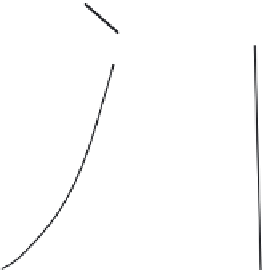Environmental Engineering Reference
In-Depth Information
Rated Speed
100
Power Output
(% of Rated Output)
0
Wind Speed (m/s)
Cut -in Speed
Cutout Speed
Figure 10: Typical wind turbine power curve .
the power output reaches its maximum value, defi ned as the rated power output. Cor-
respondingly, the speed at this point is defi ned as the rated speed. At the rated speed,
more increase in the wind speed will not increase the power output due to the activa-
tion of the power control. When the wind speed becomes too large to potentially
damage the wind turbine, the wind turbine needs to shut down immediately to avoid
damaging the wind turbine. This wind speed is defi ned as the cut-out speed. Thus,
the cut-in and cut-out speeds have defi ned the operating limits of the wind turbine.
There are a number of methods available for forecasting the wind turbine power
performance curves. Based on statistical tools, a comparison of fi ve different
methods has been performed by Cabezon
et al.
[45]. The best results were obtained
when the fuzzy logic tool and tuning over the transfer functions were applied for
wind turbines. More recently, based on a stochastic model for the power conver-
sion process, Gottschall and Peinke [46] proposed a dynamic method for estimat-
ing the power performance curves and the dynamic approach has verifi ed to be
more accurate than the common IEC standard [47]. A novel method, based on the
stochastic differential equations of diffusive Markov processes, was developed to
characterize wind turbine power performance directly from high-frequency fl uctu-
ating measurements [48].
5.3.5 Tip speed ratio
The tip speed ratio is an extremely important factor in wind turbine design, which
is defi ned as the ratio of the tangential speed at the blade tip to the actual wind
speed, i.e.:
(
lr
u
+
)
w
l
=
(24)
where
l
is the length of the blade,
r
is the radius of the hub, and
w
is the angular
speed of blades.












Search WWH ::

Custom Search